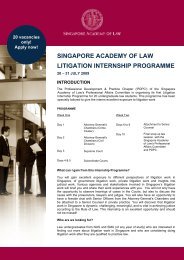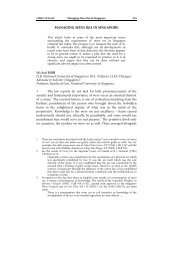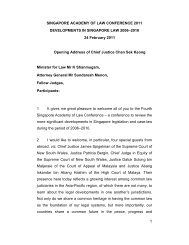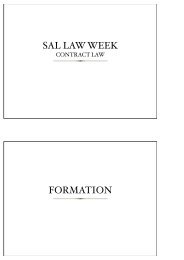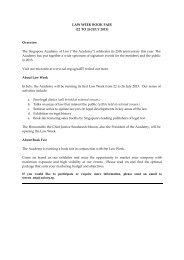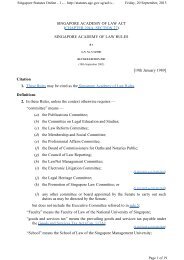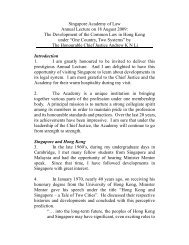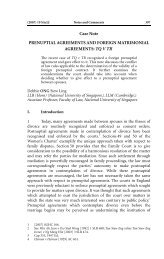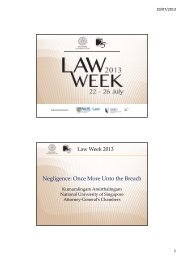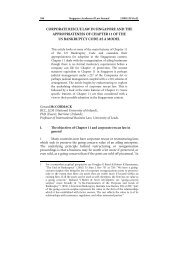View Article - Singapore Academy of Law
View Article - Singapore Academy of Law
View Article - Singapore Academy of Law
Create successful ePaper yourself
Turn your PDF publications into a flip-book with our unique Google optimized e-Paper software.
15 SAcLJ Matrimonial Assets and the 3 rd Party 289<br />
190 Consolidation may be ordered where the parties could have been<br />
joined in a single action pursuant to Order 15 Rule 4. 116 It should be<br />
noted that:<br />
“If an order for consolidation had been made, only one set <strong>of</strong><br />
solicitors would represent the lead plaintiff and the<br />
determination <strong>of</strong> the court would bind all parties. The other<br />
plaintiffs would have to pay the costs <strong>of</strong> their solicitors with no<br />
recourse against or indemnity from the defendants.” (per Lai<br />
Kew Chai J, Lee Kuan Yew v Tang Liang Hong & Anor and<br />
other actions (3) 117 at paragraph 4)<br />
191 In Lee Kuan Yew v Tang Liang Hong, supra, it was held that it<br />
was generally impossible to consolidate actions where the plaintiffs in<br />
the actions had been and continued to be represented by different<br />
solicitors who had, in each case, completed their research, getting-up<br />
and, had been in the process <strong>of</strong> discovery <strong>of</strong> documents and other<br />
information “in relation to matters which could extend back a quarter <strong>of</strong><br />
a century” 118 This was because it would not be possible to obtain the<br />
agreement <strong>of</strong> all the parties regarding the conduct <strong>of</strong> the action, and it<br />
would be “unjust and too overbearing” 119 to compel all the parties to<br />
agree to one set <strong>of</strong> solicitors, to terminate their retainers <strong>of</strong> their<br />
solicitors, and pay their solicitor and client costs without the prospect <strong>of</strong><br />
any recourse from the defendants should the plaintiffs succeed in their<br />
claims.<br />
192 The court in Lee Kuan Yew v Tang Liang Hong & Anor and<br />
other actions (3), supra, was <strong>of</strong> the view that where it was not possible<br />
for multiple actions to be consolidated, the next best alternative was to<br />
order that they be tried at the same time.<br />
193 There seems to be little practical difference between<br />
consolidation and ordering actions to be tried at the same time, aside<br />
from the issues <strong>of</strong> separate legal representation and costs. The court<br />
observed that “In a trial <strong>of</strong> all the actions at the same time, the<br />
attendances <strong>of</strong> witnesses, counsel and <strong>of</strong> the parties need not be<br />
repeated. Counsel for plaintiffs and defendants in most cases <strong>of</strong> trials <strong>of</strong><br />
multiple actions at the same time had in practice sensibly agreed that<br />
116 See <strong>Singapore</strong> Court Practice 2003, Jeffrey Pinsler, at p 70, para 4/1/1<br />
117 [1997] 3 SLR 178<br />
118 per Lai Kew Chai J, Lee Kuan Yew v Tang Liang Hong & Anor and other actions (3),<br />
supra, at para 4.<br />
119 Ibid, at para 11.



